[Info] The 1940 Imperial Census
- Location
- Romania
The 1940 Imperial Census
Caution: Some of the categories, wording and interpretations of this census and of its data may make a person with present day sensibilities cringe. Please remember that the world was quite different 80 years ago.
Introduction
The May 1940 Imperial Census was conducted with haste in the short period between the 10th of May Unification of the Realms and the 8th of June invasion of Turkey which marked the Romanian entry into World War Two. It was the first census of the Empire (still officially called the Danubian Confederation at that time) and the first one in Romania since 1930. The analysis of the census data was not completed until the spring of 1941 and some data did not become publicly available until several years later.
In order to preserve the limited human resources for the upcoming war effort, the census was conducted by volunteers and the able bodied population was encouraged to come to the town halls and provide the required information themselves. The haphazard organization of the census notwithstanding, the collected data is widely considered representative and accurate.
Collected Data
The population was asked to provide the following data, if applicable, which were later typed in an Identity Booklet and converted to a punched card friendly form.
1. "Ambigene" means "true hermaphrodite", i.e. the undisputed presence of both male and female gonads in the same organism (usually a "chimera"). It is extremely rare.
"Unclear" means "ambiguous external genitalia", i.e. either males or females with some genetic (chromosomial) disorder which may make the obstetrician unsure about what sex to assign to the baby. It is rare.
"Unknown" means "no data collected", the sex is completely unknown because, for example, the person refused to state their sex / gender (and the censor did not determine it). It is very rare.
2. It is not clear what "method" was employed in determining the "real ethnicity" as opposed to the "declared ethnicity".
3. Probably arbitrary in some cases.
4 & 5. The existence of "civil unions" as opposed to religious "marriages" will probably have interesting repercussions later on.
The idea was: "The state does not perform marriages, only the religious authorities do. However, the civil unions have the same legal consequences as marriages and create the same rights and responsabilities."
Identity Booklet and PIN
All citizens and residents were assigned a 32 digit immutable PIN (cod numeric personal, CNP).
All citizens, residents and foreigners over the age of twelve received a small, A6 size (105 × 148 mm), Identity Booklet (carte de identitate, CID) over the following year, which contained a black and white photograph, the PIN and various personal data.
A small subset of those data (because much of them were not applicable to children) was available in the Birth Certificates, which were used by children or by their parents or guardians in place of the Identity Booklets when needed or asked for. Similarly, a relevant subset of those data was available in the Death Certificates.
With the expansion of the Empire during the following years, the above system was applied (with little changes) to an ever increasing number of Imperial subjects.
Census Statistics
Sex Ratio (Males / Female): 1.08 (for the citizens), 1.05 (total). The sex ratio was a little lower for the residents, being skewed downwards by the large number of Polish refugees who were mostly soldiers and, thus, males.
Citizenship Status

.

Real Ethnicity

Declared Ethnicity

Race

Proficiency in Romanian

Fluency in Languages

Religion

6. In all of the above, "Unknown" means "data not collected", for various reasons.
7. In all of the above, "Other(s)" means that the data is known but that it is not one of the major groups (for example the small numbers of Baha'i, Pagans, etc, were placed in the "Other religions" catch all category).
No census was performed in Romanian Africa (later the de jure Republic of Equafrica).
It was estimated that:
Very little was known about the small population of Annobón, except that they were Africans or of mixed race, Roman Catholics and spoke Portuguese or a Portuguese creole.
Caution: Some of the categories, wording and interpretations of this census and of its data may make a person with present day sensibilities cringe. Please remember that the world was quite different 80 years ago.
Introduction
The May 1940 Imperial Census was conducted with haste in the short period between the 10th of May Unification of the Realms and the 8th of June invasion of Turkey which marked the Romanian entry into World War Two. It was the first census of the Empire (still officially called the Danubian Confederation at that time) and the first one in Romania since 1930. The analysis of the census data was not completed until the spring of 1941 and some data did not become publicly available until several years later.
In order to preserve the limited human resources for the upcoming war effort, the census was conducted by volunteers and the able bodied population was encouraged to come to the town halls and provide the required information themselves. The haphazard organization of the census notwithstanding, the collected data is widely considered representative and accurate.
Collected Data
The population was asked to provide the following data, if applicable, which were later typed in an Identity Booklet and converted to a punched card friendly form.
- Name (given name(s), middle name(s), family name(s), patronyms, other names)
- Other Names (maiden name, previous name(s), pen name(s), alias(es), unofficial baptismal name(s), monastic name(s), etc)
- Names in Native Script (Cyrillic, Greek, Hebrew, Armenian, Georgian, etc)
- Date of Birth (Gregorian calendar)
- Place of Birth (country, administrative unit, inhabited place)
- Sex (feminine, masculine, ambigene, unclear, unknown, reserved)¹
- Father (name)
- Mother (name)
- Height (centimetres)
- Weight (kilogrammes)
- Eye Colour
- Hair Colour
- Distinctive Signs (scars, tattoos, etc)
- Citizenship
- Other Citizenships
- Previous Citizenships
- Real Ethnicity²
- Declared Ethnicity
- Previous Ethnicities
- Ancestry
- Regional Identities
- Race (European, Semitic, Turanic, Indian, Asian, Pacific, Aboriginal, Amerindian, African, reserved, other, mixed, unknown)³
- Languages (with proficiency: native or near native, fluent, medium, basic, unknown, reserved)
- Religion
- Other Religions
- Previous Religions
- Education (illiterate, primary school, secondary school, high school, baccalaureate, university, master in sciences / arts, doctor in sciences / arts, member of the academy, reserved, other, homeschooled, unknown)
- Professions
- Current Jobs
- Previous Jobs
- Other Skills
- Military Status (none, recruit, volunteer, active, honourably discharged, dishonourably discharged, reserved, other, unknown)
- Military Branch (none, infantry, artillery, cavalry, armour, engineers, special forces, air defence, air force, navy, reserved, other, none, auxiliaries)
- Military Rank
- Mentions (military)
- Driving Licences (vehicles)
- Mentions (driving)
- Criminal Convictions
- Awards
- Civil Rights (national importance, citizen, citizen with reduced rights, resident, resident with reduced rights, foreign diplomat, stateless, foreigner, enemy, reserved, other, unknown)
- Civil Status (single, civil union, other, unclear, unknown, separated, widowed, reserved)⁴
- Marital Status (single, married, other, unclear, unknown, separated, divorced, cancelled, widowed, reserved)⁵
- Children (number & years of birth)
- Politics (optional)
- Rank of Nobility
- Blood Group
- Allergies
- Surgeries
- Health Issues
- Required Medicine
- Main Address (country, administrative unit, inhabited place, street, house number, flat number)
- Other Addresses
- Write-in Fields
1. "Ambigene" means "true hermaphrodite", i.e. the undisputed presence of both male and female gonads in the same organism (usually a "chimera"). It is extremely rare.
"Unclear" means "ambiguous external genitalia", i.e. either males or females with some genetic (chromosomial) disorder which may make the obstetrician unsure about what sex to assign to the baby. It is rare.
"Unknown" means "no data collected", the sex is completely unknown because, for example, the person refused to state their sex / gender (and the censor did not determine it). It is very rare.
2. It is not clear what "method" was employed in determining the "real ethnicity" as opposed to the "declared ethnicity".
3. Probably arbitrary in some cases.
4 & 5. The existence of "civil unions" as opposed to religious "marriages" will probably have interesting repercussions later on.
The idea was: "The state does not perform marriages, only the religious authorities do. However, the civil unions have the same legal consequences as marriages and create the same rights and responsabilities."
Identity Booklet and PIN
All citizens and residents were assigned a 32 digit immutable PIN (cod numeric personal, CNP).
All citizens, residents and foreigners over the age of twelve received a small, A6 size (105 × 148 mm), Identity Booklet (carte de identitate, CID) over the following year, which contained a black and white photograph, the PIN and various personal data.
A small subset of those data (because much of them were not applicable to children) was available in the Birth Certificates, which were used by children or by their parents or guardians in place of the Identity Booklets when needed or asked for. Similarly, a relevant subset of those data was available in the Death Certificates.
With the expansion of the Empire during the following years, the above system was applied (with little changes) to an ever increasing number of Imperial subjects.
Census Statistics
Sex Ratio (Males / Female): 1.08 (for the citizens), 1.05 (total). The sex ratio was a little lower for the residents, being skewed downwards by the large number of Polish refugees who were mostly soldiers and, thus, males.
Citizenship Status
- Subjects: 57,604,319
- Imperial Citizens: 46,739,872 (81.14%)
- Former Romanian citizens: 20,038,593 (34.79%)
- Former Hungarian citizens: 9,496,607 (16.49%)
- Former Bulgarian citizens: 6,402,133 (11.11%)
- Former Czechoslovak citizens (Slovakia and Ruthenia): 4,574,850 (7.94%)
- Former Yugoslav citizens (Serbia Proper and areas annexed in 1939): 5,725,188 (9.94%)
- Former Greek citizens (Western Thrace, annexed in 1940): 319,175 (0.55%)
- Former citizens of other countries: 183,326 (0.32%)
- Imperial Residents: 1,686,886 (2.93%)
- Polish refugees: 174,794 (0.30%)
- Jews expelled by the German Reich: 1,065,730 (1.85%)
- Other people expelled by the German Reich and by Italy: 343,506 (0.60%)
- Other residents: 102,856 (0.18%)
- Population of the Romanian Occupation Zones: 9,177,561 (15.93%)
- Croat citizens: 4,183,010 (7.26%)
- Greek citizens: 4,994,551 (8.67%)
- Imperial Citizens: 46,739,872 (81.14%)
- Foreigners: 66,545
- Unknown status⁶: 1,248
- Loyal subjects in the diaspora: 1,500,000 - 2,000,000
- Pokuttya (administered by the Soviet Union): ~80,000
- Tiraspol (Soviet Union): ~35,000
- other parts of the Soviet Union: ~2,500
- Turkey: ~100
- German Reich: ~90,000
- Italian Occupation Zone in Croatia: ~800,000
- Montenegro: ~180,000
- Albania: ~120,000
- Italian Occupation Zone in Greece: ~250,000
- Western Europe: ~100,000
- North America: ~150,000
- South America, Australia, New Zealand, South Africa: ~30,000
- other parts of the World: <10,000
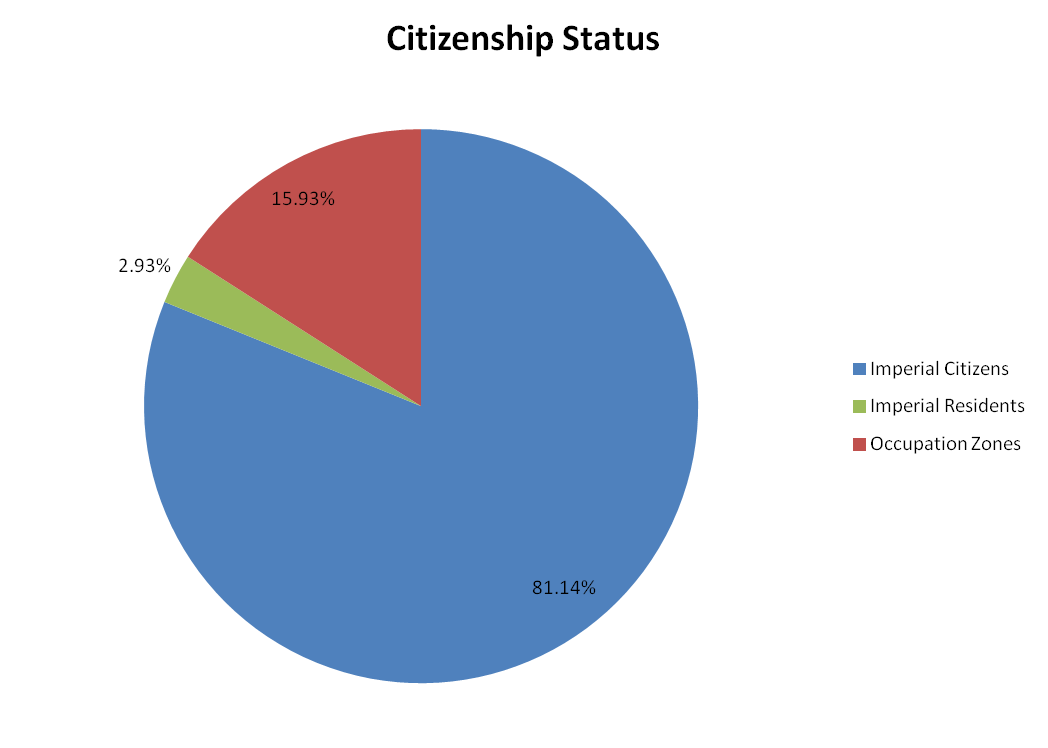
.
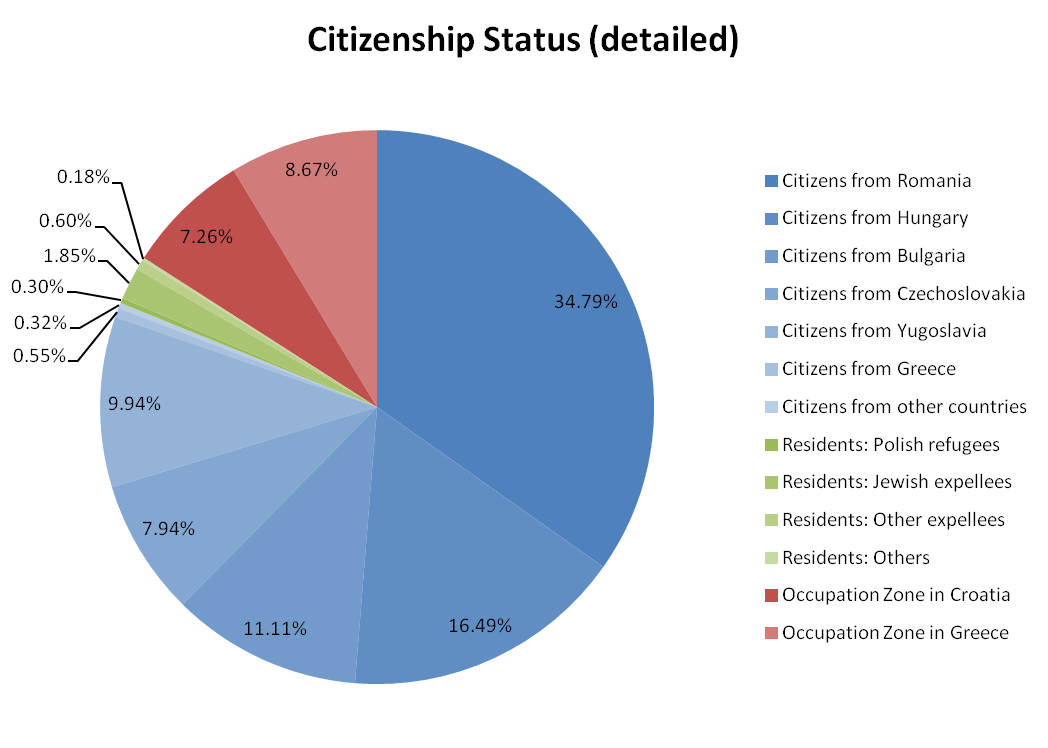
Real Ethnicity
- Romanians: 16,450,949 (28.56%)
- Hungarians: 12,030,485 (20.88%)
- Bulgarians: 6,338,903 (11.00%)
- Serbs: 5,013,556 (8.70%)
- Slovaks: 3,103,394 (5.39%)
- Germans: 1,193,660 (2.07%)
- Ukrainians: 838,405 (1.46%)
- Russians: 455,948 (0.79%)
- Poles: 157,453 (0.27%)
- Croats: 3,875,121 (6.73%)
- Czechs: 72,384 (0.13%)
- Slovenes: 14,400 (0.02%)
- Albanians: 30,888 (0.05%)
- Italians: 10,327 (0.02%)
- Greeks: 225,831 (0.39%)
- Turks: 405,506 (0.70%)
- Tatars: 28,433 (0.05%)
- Armenians: 17,430 (0.03%)
- Jews: 2,485,383 (4.31%)
- Gypsies: 991,305 (1.72%)
- Others⁷: 8,390 (0.015%)
- Mixed: 3,852,648 (6.69%)
- Unknown⁶: 3,520 (0.006%)
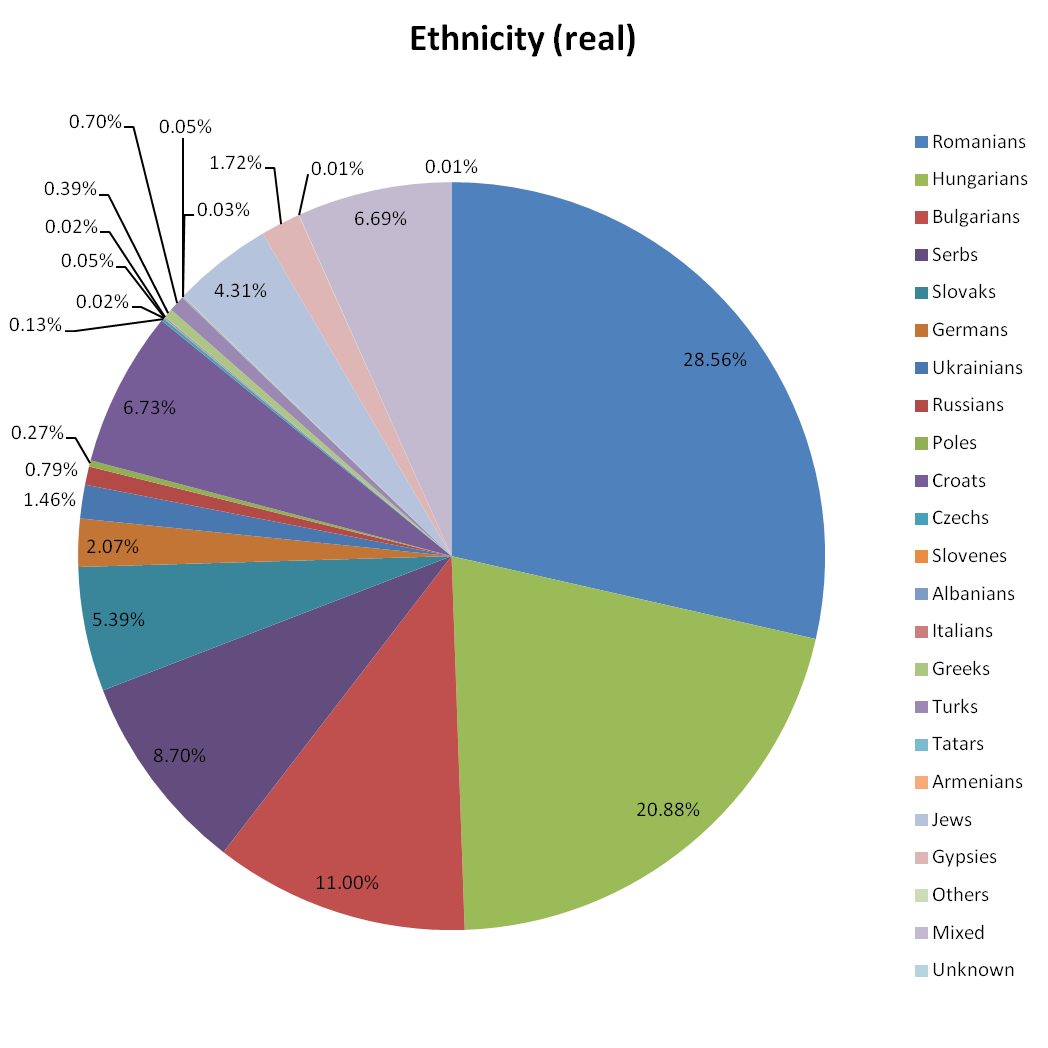
Declared Ethnicity
- Romanians: 20,892,044 (36.27%)
- Hungarians: 11,640,949 (20.21%)
- Bulgarians: 6,405,498 (11.12%)
- Serbs: 5,240,551 (9.10%)
- Slovaks: 3,004,052 (5.21%)
- Germans: 1,407,830 (2.44%)
- Ukrainians: 665,388 (1.16%)
- Russians: 423,056 (0.73%)
- Poles: 167,332 (0.29%)
- Croats: 3,912,211 (6.79%)
- Czechs: 70,237 (0.12%)
- Slovenes: 14,375 (0.02%)
- Albanians: 36,290 (0.06%)
- Italians: 13,748 (0.02%)
- Greeks: 238,458 (0.41%)
- Turks: 415,930 (0.72%)
- Tatars: 26,063 (0.05%)
- Armenians: 17,113 (0.03%)
- Jews: 1,919,455 (3.33%)
- Gypsies: 236,364 (0.41%)
- Others⁷: 9,996 (0.02%)
- Danubians: 847,379 (1.47%)
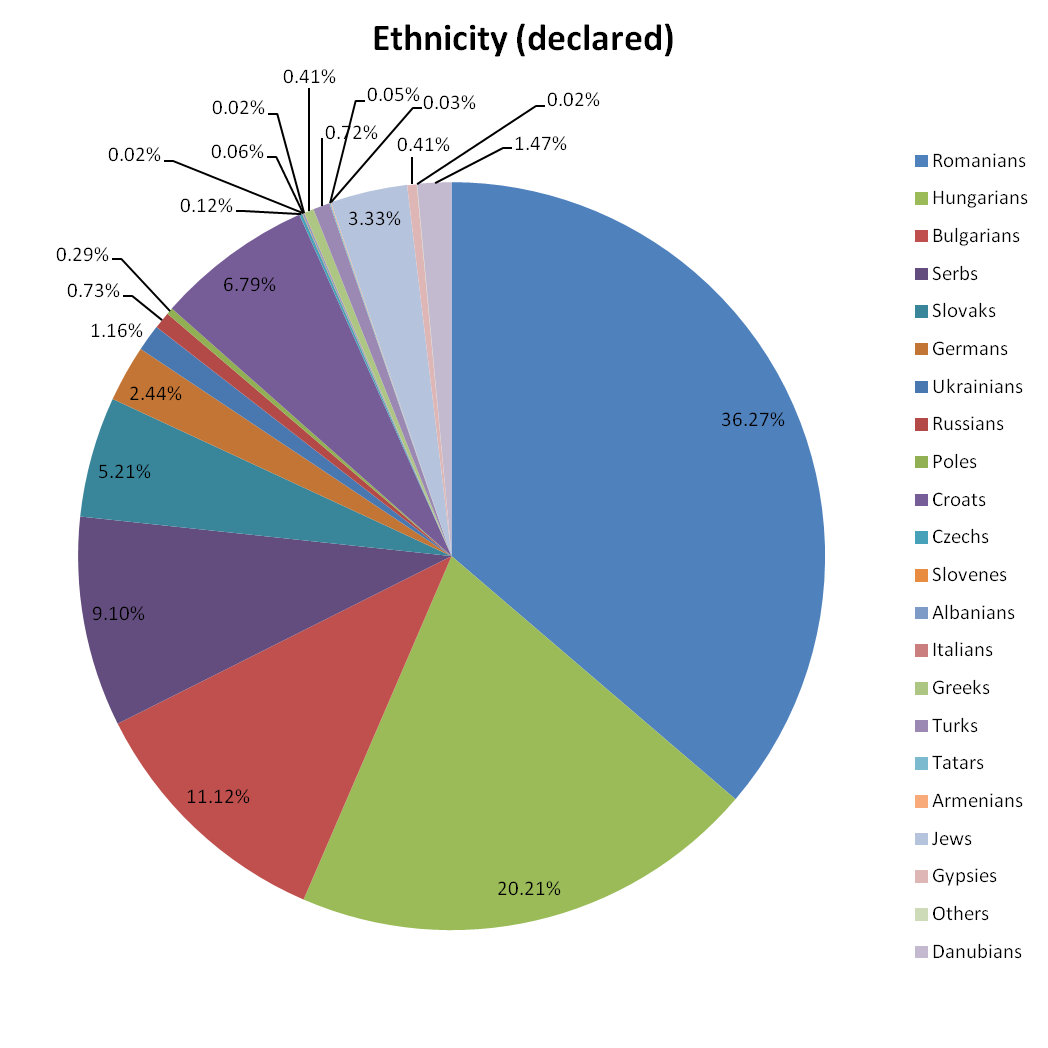
Race
- Europeans: 52,280,754 (90.76%)
- Semites: 108,436 (0.19%)
- Turanics: 276,677 (0.48%)
- Indians: 360,689 (0.63%)
- Others⁷: 2,205 (0.004%)
- Mixed: 4,575,188 (7.94%)
- Unknown⁶: 370 (0.001%)
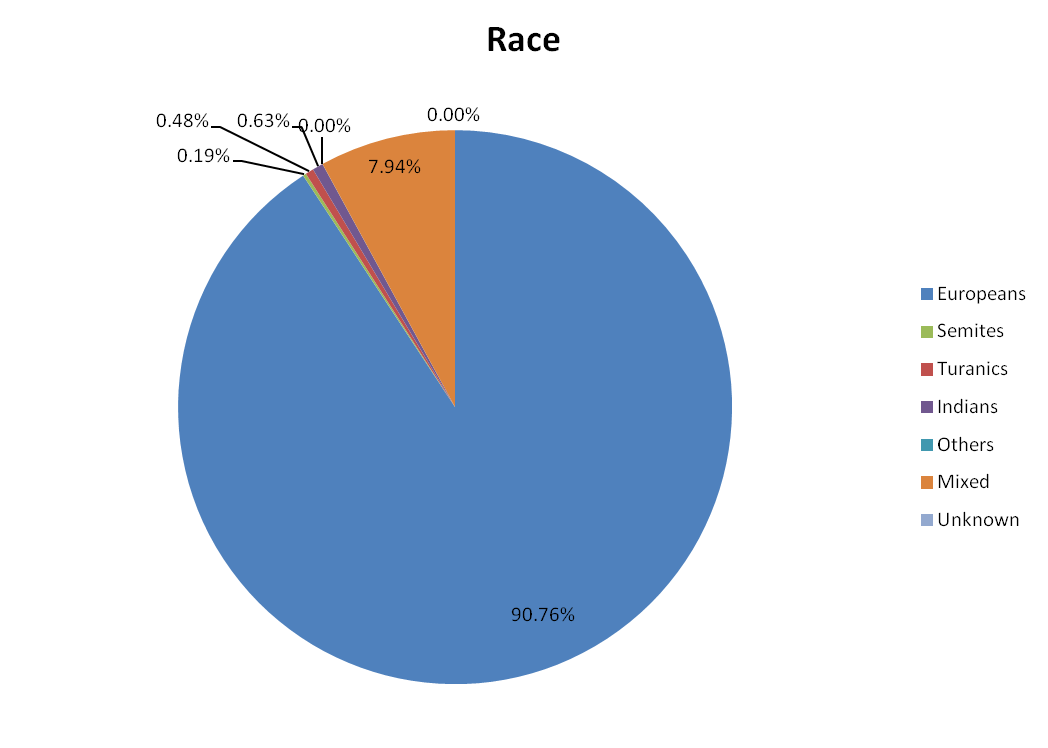
Proficiency in Romanian
- Native: 17,982,327 (31.22%)
- Fluent: 4,300,726 (7.47%)
- Medium: 1,084,525 (1.88%)
- Basic: 7,604,594 (13.20%)
- None: 26,612,513 (46.20%)
- Unknown⁶: 19,634 (0.03%)
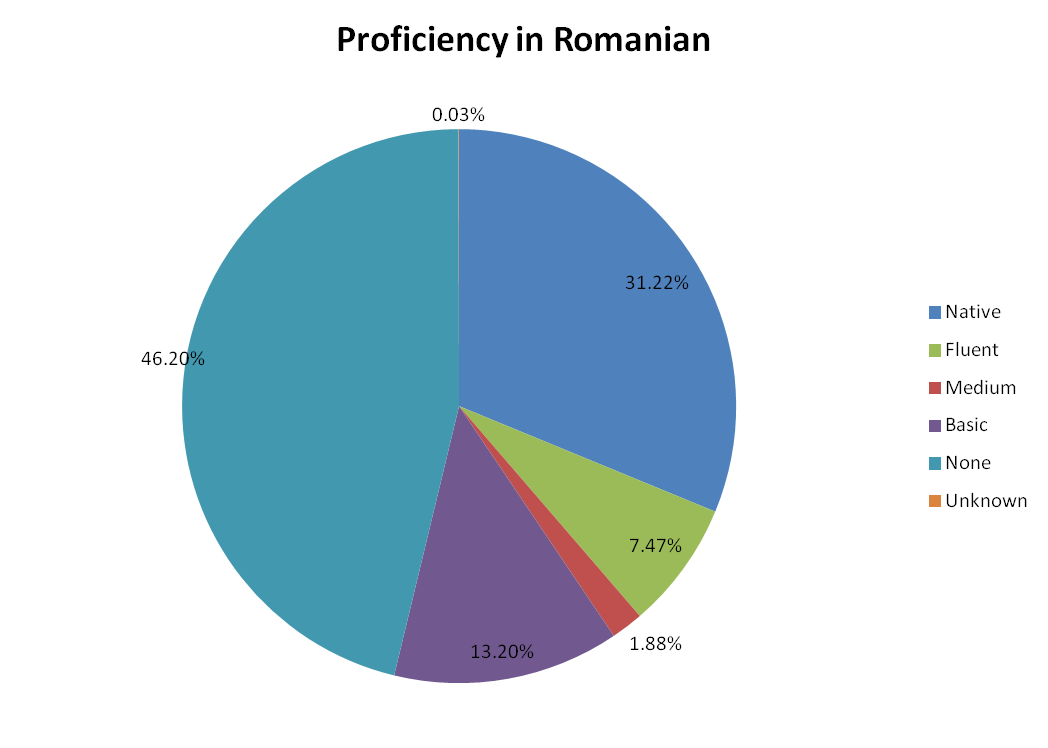
Fluency in Languages
- One: 46,363,004 (80.49%)
- Two: 8,752,409 (15.19%)
- Three: 908,485 (1.58%)
- More than three: 1,246,091 (2.16%)
- Mutes / Cretins: 301,292 (0.52%)
- Unknown⁶: 33,038 (0.06%)
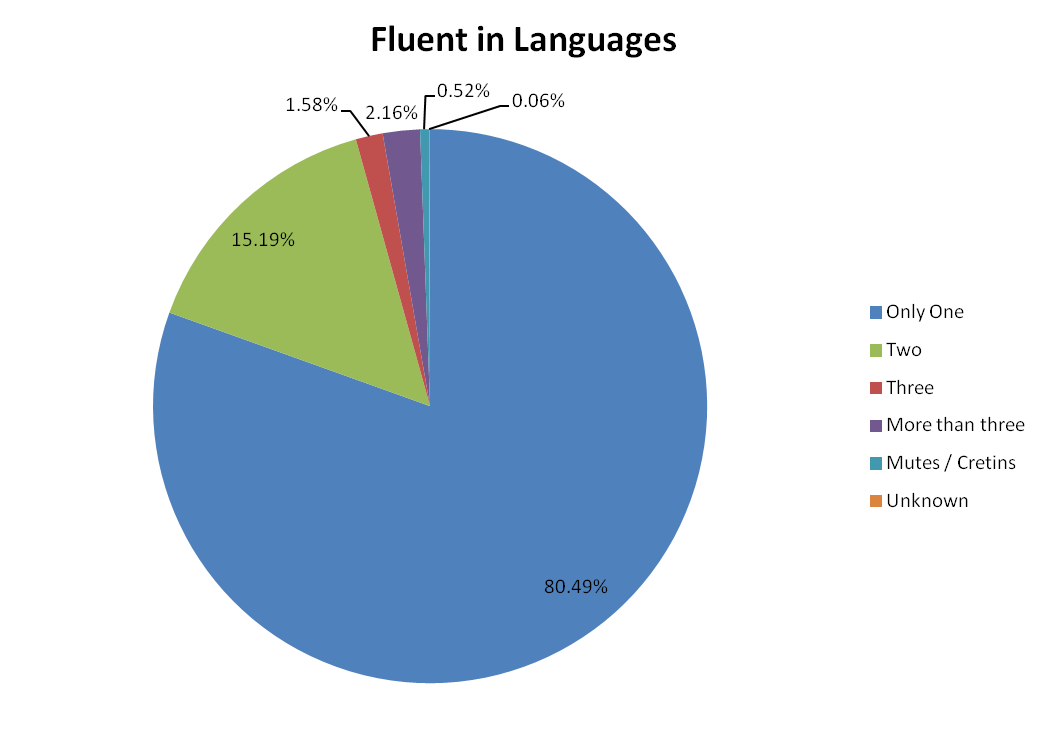
Religion
- Christianity: 53,341,145 (92.60%)
- Orthodoxy: 32,204,503 (55.91%)
- Roman Catholicism: 20,085,043 (34.87%)
- Protestantism: 1,025,669 (1.78%)
- Armenian Christianity: 16,832 (0.03%)
- Oriental Christianity: 1,288 (0.002%)
- Other Christian denominations: 7,810 (0.014%)
- Judaism: 2,220,616 (3.85%)
- Islam: 558,740 (0.97%)
- Other⁷: 14,399 (0.02%)
- None: 1,223,879 (2.12%)
- Unknown⁶: 245,540 (0.43%)
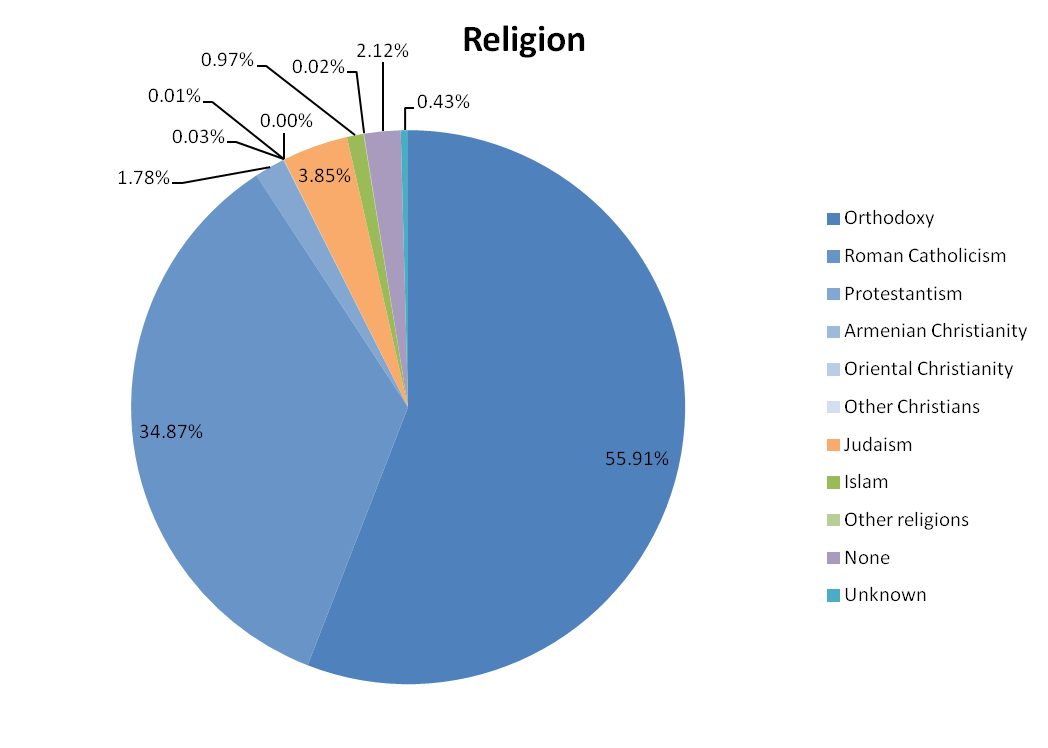
6. In all of the above, "Unknown" means "data not collected", for various reasons.
7. In all of the above, "Other(s)" means that the data is known but that it is not one of the major groups (for example the small numbers of Baha'i, Pagans, etc, were placed in the "Other religions" catch all category).
No census was performed in Romanian Africa (later the de jure Republic of Equafrica).
It was estimated that:
- The population of Romanian Africa was around one hundred thousand inhabitants.
- Over 99% of them were native Africans.
- Almost all of them were Roman Catholics, with a more or less native religious substratum / syncretic influence.
- Besides an unknown number of native languages from the Bantu language family and several creoles, about half of the population could speak or understand Spanish.
Very little was known about the small population of Annobón, except that they were Africans or of mixed race, Roman Catholics and spoke Portuguese or a Portuguese creole.
Last edited:



